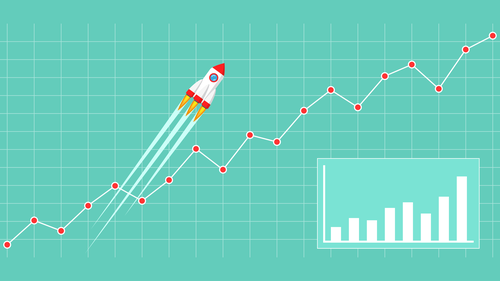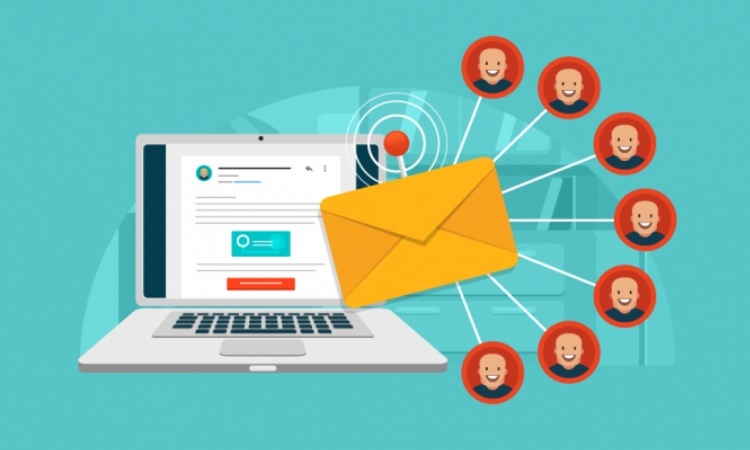
Email is one of the most powerful marketing tools we have, but for it to be effective, it is necessary to have strategies in place to properly engage your email subscribers. In this blog post, I propose 15 ideas for email marketing campaigns to ensure that you make a difference, improve your results and get loyal subscribers through your newsletters (with real examples!).
Today, businesses and brands have a wide range of ways to communicate with their audience, especially thanks to social networks. However, email still represents a highly effective direct communication channel capable of creating and consolidating relationships with your audience that should not be overlooked.
Advantages of Email Marketing
Within the marketing strategy of a brand or company, email marketing is much more than a distribution channel. In fact, newsletter campaigns are a fundamental piece in strengthening your content strategy and connecting it with the rest of your online marketing plan.
But, in addition to this, there are other benefits to the use of email marketing strategies, such as:
- You can reach a global audience.
- It allows you to send fully personalised and messages to a segmented audience.
- The investment is minimal.
- The results are measurable.
- It is a very powerful web traffic source.
- It is one of the most efficient ways to attract customers and induce conversions.
How to Prepare an Email Marketing Strategy
- Define and set clear objectives for your strategy.
- Choose a good email marketing tool.
- Create a subscriber list.
- Start capturing leads.
- Prepare and send your email and newsletter campaigns.
The first two steps are the basis of any action you are going to take. A good email marketing strategy has to go hand in hand with the right tool and, before taking action, you must have specific objectives to ensure you know what you want to achieve:
- Get new subscribers?
- Loyalty to your customers?
- Increase web traffic?
- etc.
Now, once you have defined your objectives and have the right tool at hand, another key point in this strategy arrives: to get subscribers and start filling your subscriber list.
At this stage, the generalised strategy taken by most people would be limited to creating a subscription form, placing it on the website and, once we have a certain volume of accumulated emails, a newsletter campaign is sent to everyone equally... and that's it.
This is undoubtedly a huge mistake and certainly would not be the right strategy if we really wanted to get good results. What can you do to ensure you don't fall into the same trap? Let's find out...
Segmentation: the key to success in email marketing
To avoid the generalised error of email marketing described about, you need to plan each of your actions well and segment and optimise your subscriber list.
What is Segmentation?
Within email marketing specifically, segmentation refers to the categorisation of your subscriber lists into groups based on the information that you have collected or that you are collecting from subscribers (sex, age, geographic location, interests, behaviour, etc.) with the objective of offering them content "made to measure".
Although you can sell a single product or service, your customers / subscribers do not always respond to the same marketing measures, so your emails are far less likely to succeed if you send them all the same message as compared to a tailored email that meet the individual needs of your audience.
A properly segmented audience will allow us to better:
- Get to know our target audience
- Gain loyalty from our subscribers.
- Optimise our email actions and "get to the point".
- Improve our results.
What to Consider when Segmenting?
Although this can vary, when grouping subscribers into particular segments you can take into account some of the following characteristics:
- Demographic data: Sex, age, location, income, marital status ...
- Behaviour: how the subscriber has previously interacted with the campaigns themselves, with a website, with a purchase process...
- Interests: Specific preference on products or services.
- Activity: The frequency with which subscribers interact (or not) with campaigns.
You may be asking yourself, 'why are you emphasising segmentation so much if I am looking for concrete email marketing strategies and examples?'. But, as we are seeing, if you want result when conducting your own email marketing strategies, segmentation is a key step and a basis from which you should start.
Once you have your subscriber lists well segmented, the ideal and most effective method would be to now prepare email campaigns aimed at each segment. It is here that we would arrive at the crux of the matter.
15 Email Marketing Campaign Ideas to use TODAY
1. Initial Cleaning
Yes, you read that right. An initial cleaning - before launching any type of email campaign - can drastically improve the results of these email marketing campaigns
If you have a good email marketing tool, such as Mailchimp, Mailrelay or Infusionsoft, for example, you will have access to the results and statistics of your campaigns.
Thanks to these statistics, you are able analyse two very specific metrics for this strategy that will allow you to detect which users demonstrate behaviour that does not benefit you at all:
- Bounces: (When an email does not reach the recipient's inbox).
- The "no opens": (When an email arrives in the recipient's inbox but they do not open it).
Once you detect and segment users showing this specific behaviour, prepare a campaign aimed exclusively at them and, in it, give them the possibility to unsubscribe from your list openly and clearly.
Don't be afraid to "invite" your less (or not at all) active subscribers to unsubscribe from your list. After all, they were giving you nothing. Just don't say goodbye flatly. Try to use your sense of humour or an inside joke to prevent the subscriber from feeling offended.
Often, with this type of email, they serve as a wake-up call and subscribers show interest again. But in any case, remember: What is the use of having thousands of subscribers if they don't open your emails? You are not interested in having a database with subscribers not interested in your product.
2. Welcome Email
This type of email is the key to start building trust with your subscribers and it is very important that its content and form are appropriate.
Remember that if you have obtained a new subscriber, you have the advantage that this user has a prior interest in what you have offered and you have to take advantage of it!
Of course, users who have subscribed to your list may not know you very well, so it would be good if you introduced yourself and talked a little about yourself and your brand to start building that trust we are looking for. You can take advantage of this email to show who you are, what you do and, most importantly, how you can help the user.
Take note of these additional extra tips that you can apply in this welcome email:
- Thank the subscriber
- Pitch yourself!
- Share some content from your blog or some other useful resource
- Offer some extra incentive for reading your email marketing content
- Generate some anticipation (about something happening in the future that they can't miss out on)
Grammarly Example
In this example from Grammarly, once you subscribe and gained access to Grammarly, you receive the welcome email where, in addition to receiving and reminding you of the reasons why Grammarly is great, you are encouraged by offering you a few extra free tools to help you out.
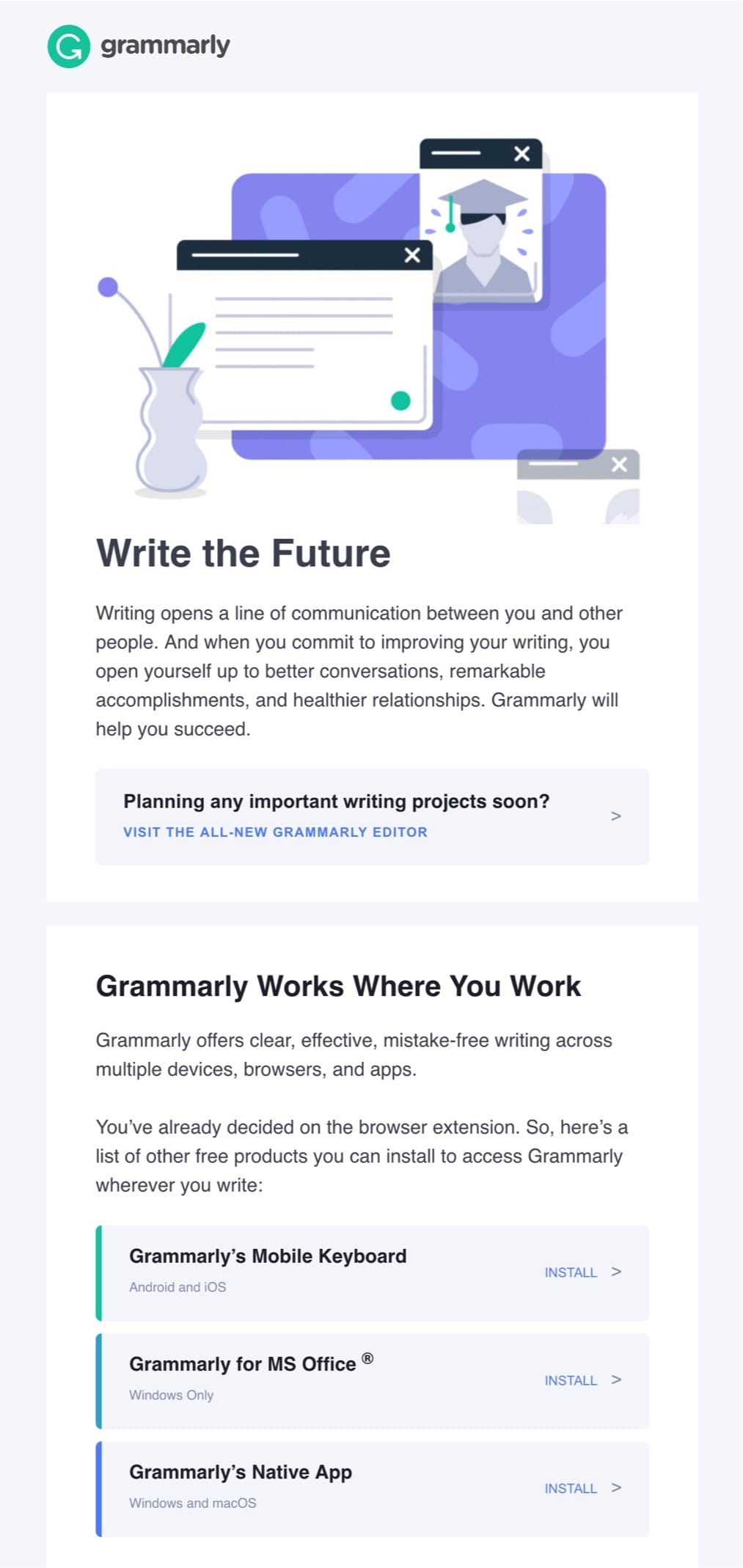
3. Share Blog Updates
You can use your emails as an extension of your blog and every time you have new content, let your subscribers know and give them access directly from their email. This is a great way to prevent your subscribers from forgetting about you and, if you also offer them valuable content adapted to their personal characteristics, you will reinforce the reasons why they wanted to subscribe in the first place: prepare powerful content and give them reasons to stay committed to you.
Later Example
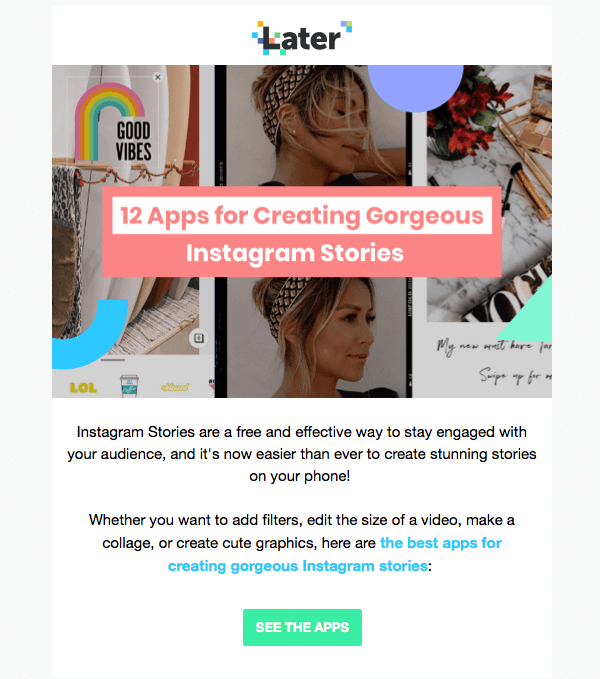
4. Announce the Launch or Improvement of a Product/Service
Notifying your subscribers of the launch of your new product or service is a very good way to keep them up to date with everything you offer as a brand.
If you use this strategy, try generating anticipation about the product/service prior to launch by dropping regular hints in your email marketing campaign that something big is about to happen.
Another option you can consider is to give your subscribers the opportunity to have exclusive access to this new product or service before anyone else. In most cases, this has a very good reception and increases the value of being part of your list.
Samsung Example
In this example, Samsung takes the opportunity to announce the launch of its new product and, in addition, gives the possibility to pre-order it exclusively.
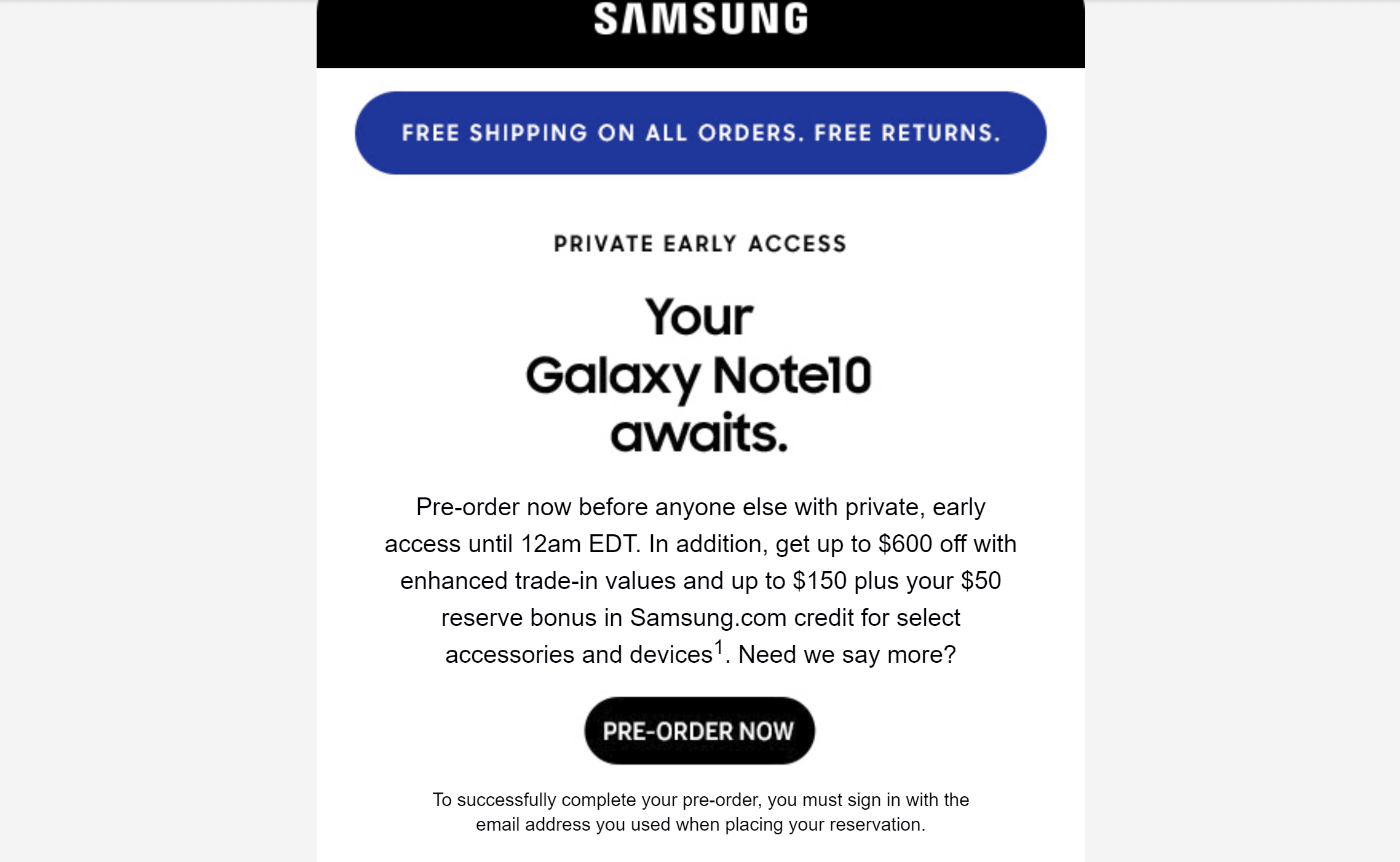
5. Keep Track
Tracking your customer movements and actions on your website gives you great number of email marketing possibilities, especially in the case of ecommerce. In particular, you could retarget people that have interacted with the products on your website to drag them back on to your site to make the sale, leading to a pretty decent conversion rate.
In the following example, from Knockaround, we see a tracking strategy for abandoned carts. In the email, in addition to reminding you that you showed interest in a particular product, they offer you an additional discount to motivate you to complete the purchase.
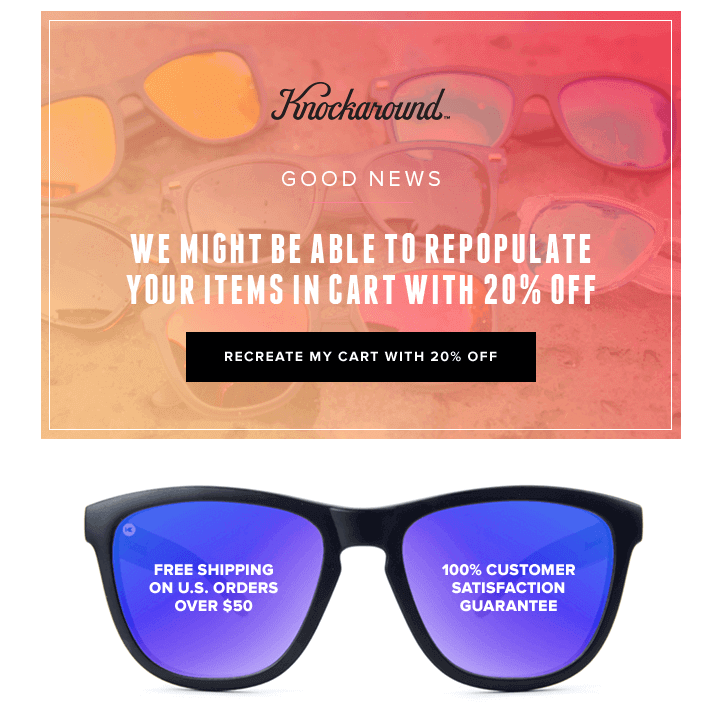
6. Conduct a Survey
A survey email may be one of the most effective emails you send. You can use it to collect more information from your subscribers, adding even more value to your database and creating new segments.
This type of strategy can help you to:
- Find out what the most specific tastes or interests of your audience are, to optimise your subscriber lists properly.
- Check how satisfied your customers are with the service offered and use it to improve accordingly
- Obtain new ideas for your business that are also adapted to the interests of the consumer so they are more likely to achieve satisfactory results.
Nando's
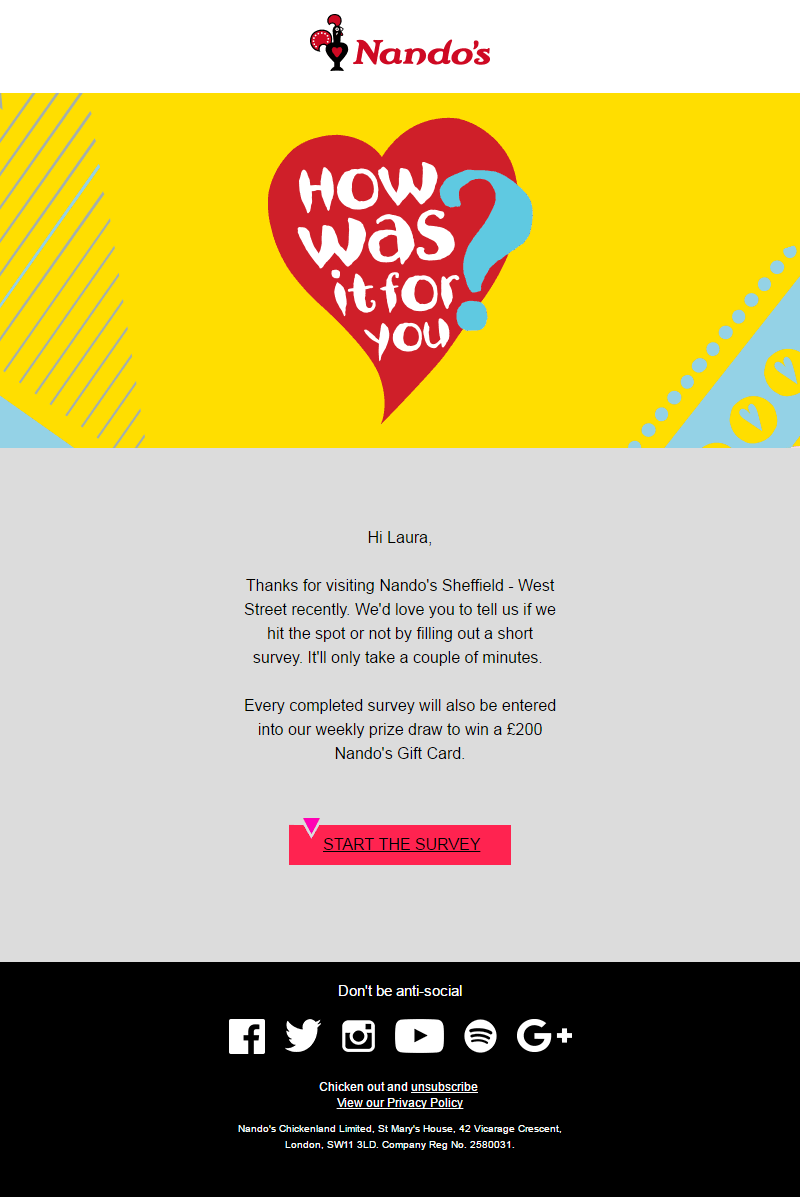
7. Request a Review or Opinion
Another strategy that you should consider is to ask your subscribers to put a value on their experience with your brand and thus boost the chance of new customers through recommendations. You can, for example, ask that they leave a review or rating on your Google My Business listing, on your Facebook page, or even on your own website.
In this type of strategy, it is advisable that you do it with caution and make sure that you know you will receive a decent recommendation or revue from the people you ask. If you are unsure about whether they had a positive experience, don't bother asking.
To do this, detect and segment your "best" subscribers or your brand ambassadors and send them this campaign.
If you also offer them "something in return" such as a discount, a free download or some other type of incentive, they will be more likely to leave you a positive message.
Adidas
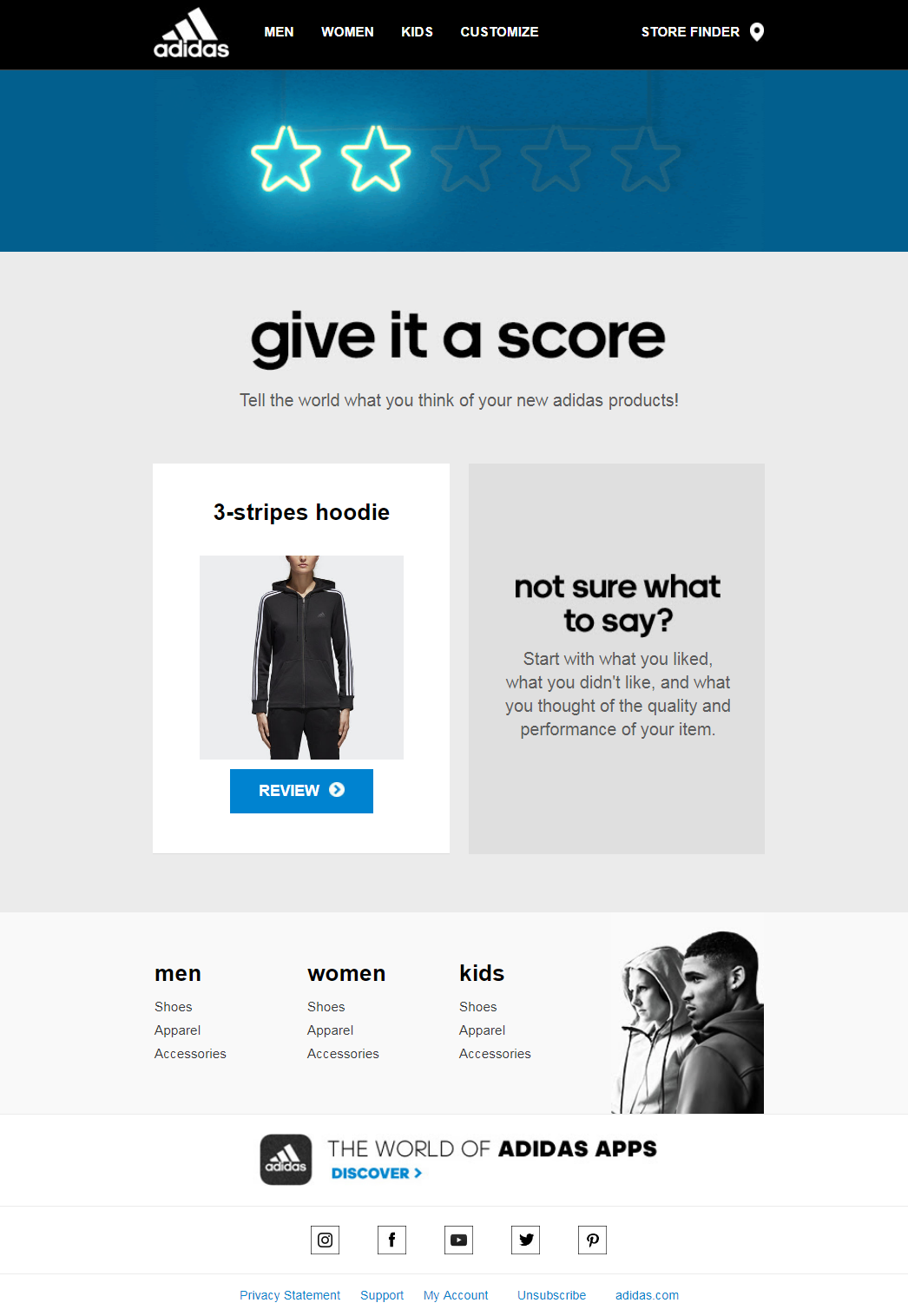
8. Shout About your Social Channels
Another way to encourage your audience to commit to your brand is by referring to your other social channels and allowing them to connect with you on these platforms.
You can prepare an exclusive campaign for this purpose or include elements in other campaigns to encourage interaction with your social channels. For example, you could use social icons at the bottom of your emails, use share buttons, display your Instagram feed, embed tweets, etc.
By doing this, we are allowing our audience to feel part of our brand and get involved through other ways than those that they already know. In turn, this helps strengthen that community and increase your brand visibility across new channels.
Check out this email from Hipmunk:
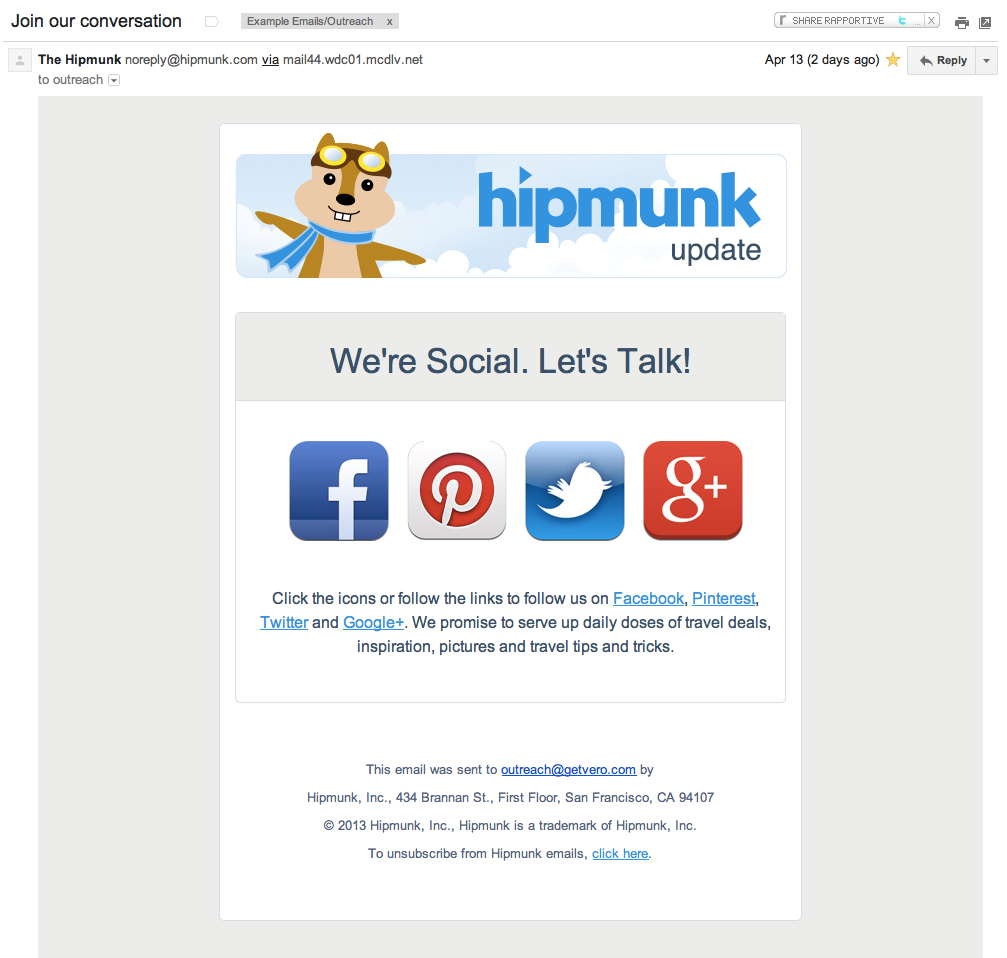
9. Encourage Specific Social Actions
In addition to the previous strategy, we also have the option of encouraging email recipients to take specific actions across our social networks. For example:
- A contest or raffle
- A participation action: game, riddle, survey ...
- A debate
- A live broadcast
- Etc
Through this strategy, we can help give greater visibility to our social content and help boost participation on our social channels, which is awesome when you consider how difficult it can be to get exposure on social networks like Facebook, where the algorithm requires decent engagement before it considers your post worthy of more impressions.
Such a campaign can be launched in advance, or even in phases, to ensure email subscribers are aware of the actions that they need to take. In addition, once the relevance content is published, you can cross-promote the content across the other social channels that you are on.
This strategy can help you achieve greater visibility across the social networks, effortlessly encourage greater participation and, consequently, further strengthen your online community.
Look like the following case study from Elements of Serenity, announces a giveaway for laser hair removal if the subscriber carries out an action on their Facebook profile. It's a fantastic idea, don't you think?
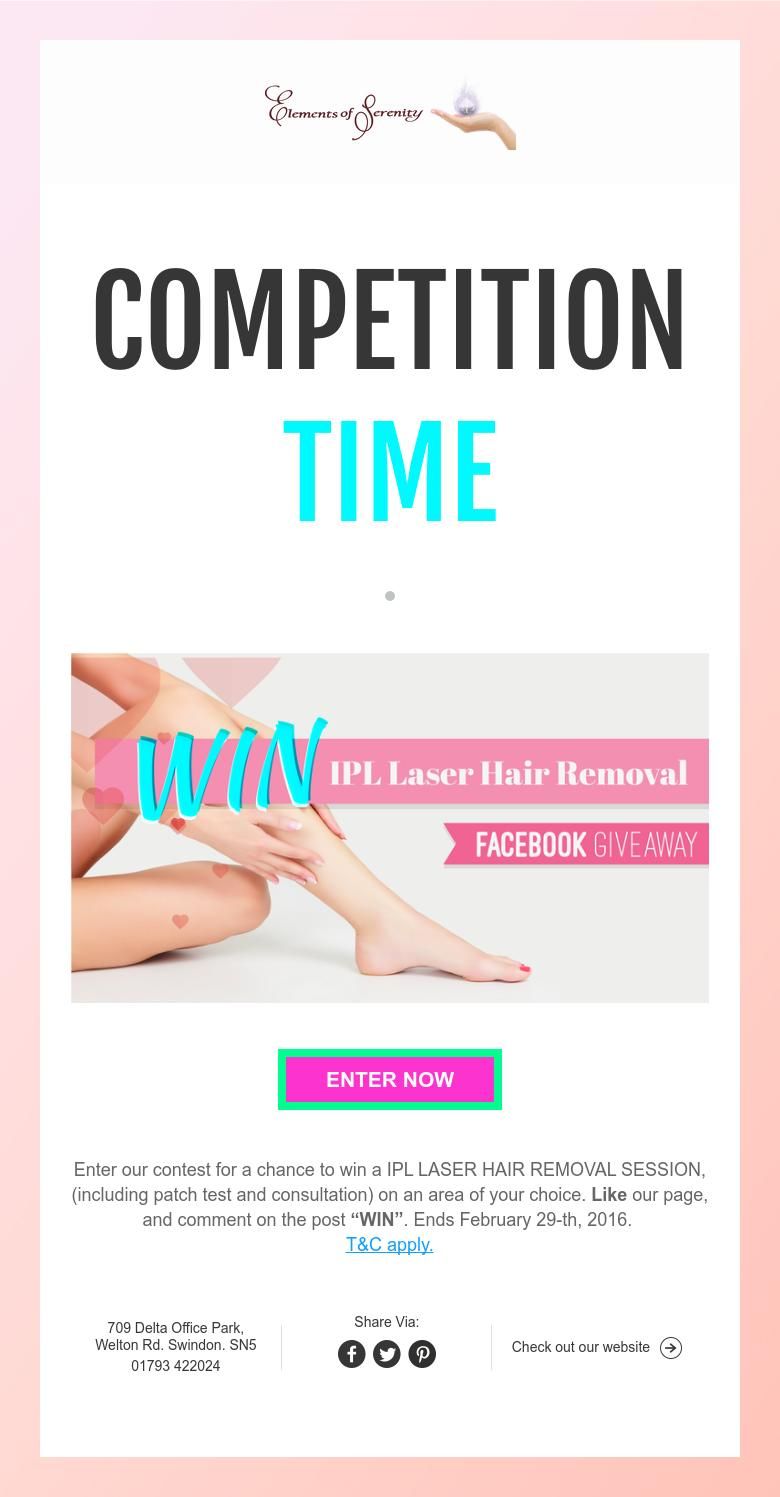
10. Offer an Exclusive Discount or Advantage
From time to time, it is worth offering to your subscribers some type of exclusive discount, offer, or some other (always exclusive) benefit for your subscribers.
This strategy is particularly suitable when your brand identity is weak, your website traffic is seasonally lower, or, even, to prompt action from less active subscribers and cold leads.
Vistaprint
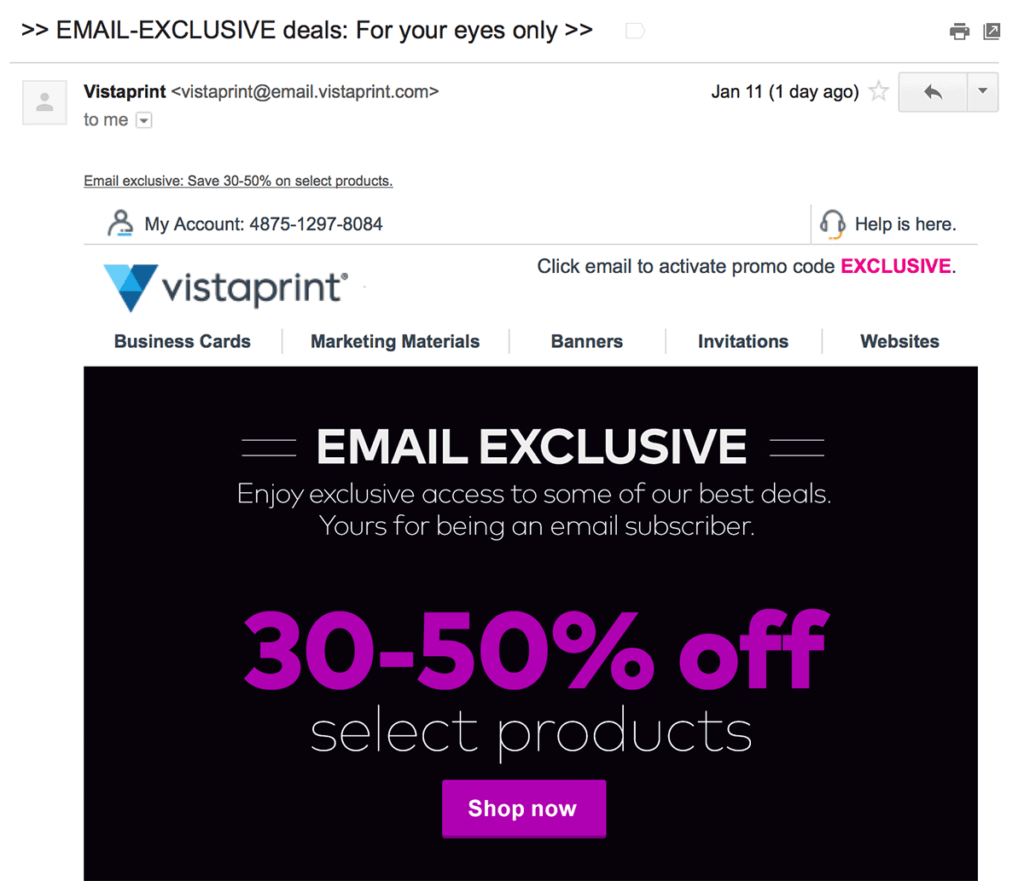
11. Share a Selection of Products
Watch out. First of all, remember that excess commercial content can have negative effects on your email marketing strategy as many people don't respond well to being directly sold to. Therefore, let's not abuse this type of campaign!
In the case of an ecommerce, it's a more common strategy, but for other types of brands or businesses being too commercial can harm you.
However, this strategy can be used from time to time to prevent subscribers from forgetting you, showing them your new product range, displaying the best selling products, and products that are currently discounted.
The ASOS online store makes very good use of this strategy. Take a look at this example:
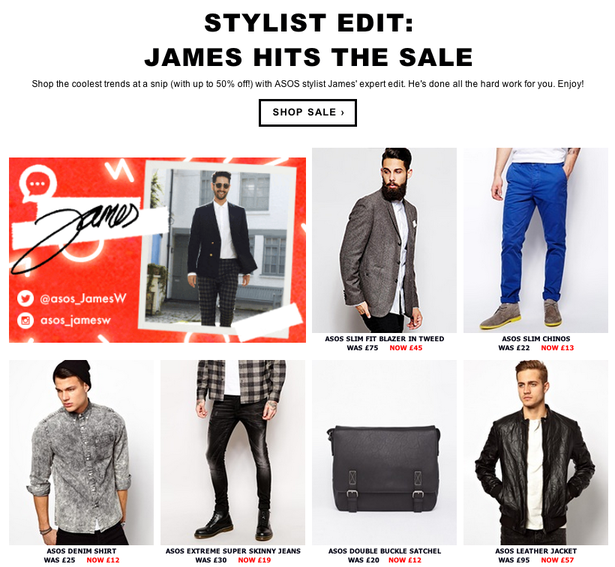
12. Announce New Collaborations
With this type of marketing strategy, you can take advantage of collaborating with brand 'friends' that complement your own brand and, therefore, offer your subscribers some additional value.
This method also allows you to get in front of new audiences. Although, ensure that the new audience you are getting in from of has similar interest to those people in your target market.
The key is that both brands collaborating in this type of campaign must work in parallel and be organised properly so that you both get the most out of it.
See how Nike make use of this type of email marketing strategy:
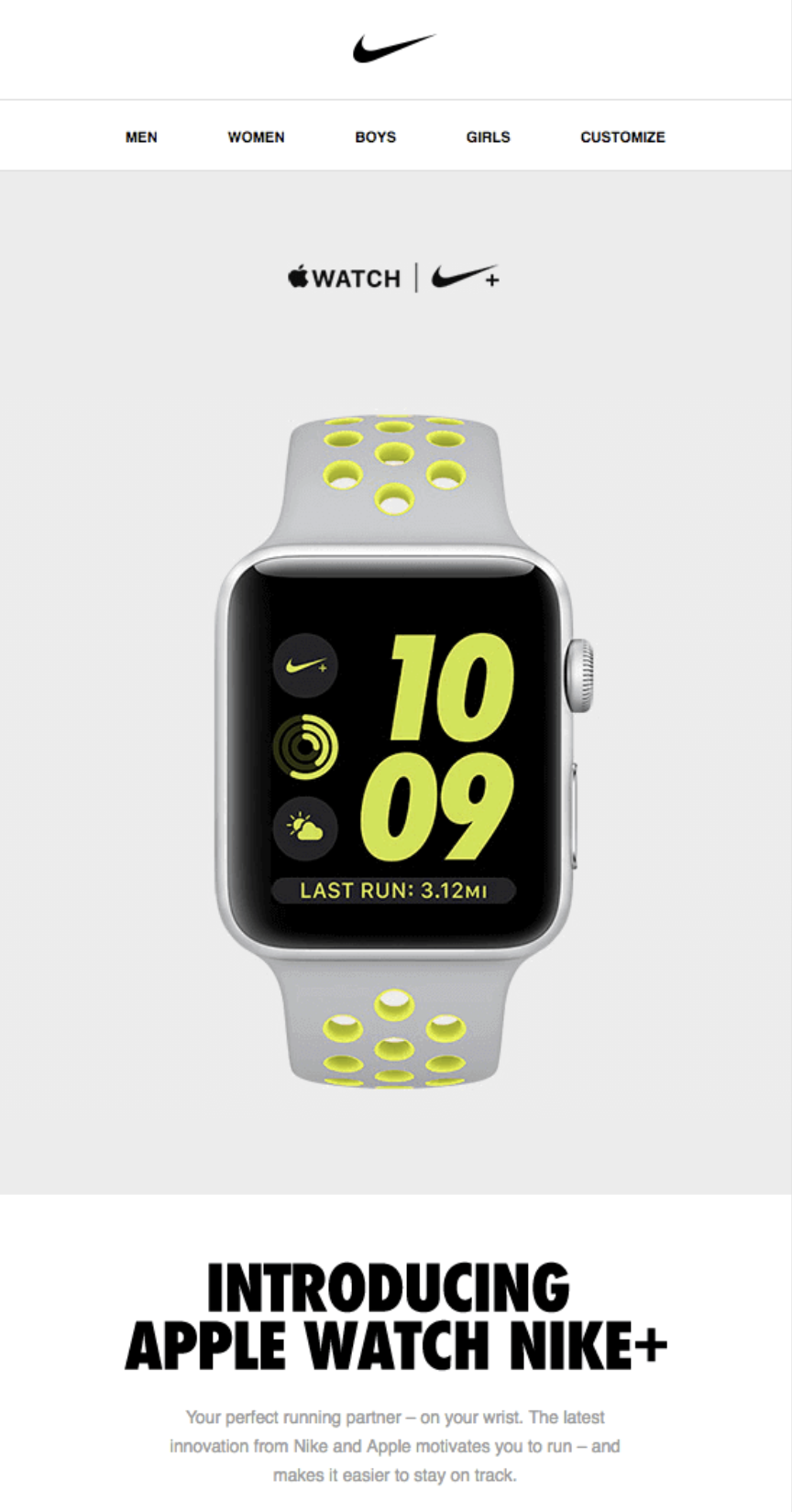
13. Gifts
Who doesn't like to get a gift? Offering your subscribers a gift, in the form of a free download (a template, an ebook, etc.) or another type of gift, is a great way to show your subscribers that you value their presence on your list.
Whether you are simply thanking and rewarding their loyalty, celebrating some specific achievement, or you're just feeling generous, this type of campaign is very effective.
However, make sure the free content or gift is something that your target audience actually wants.
Whistlefish
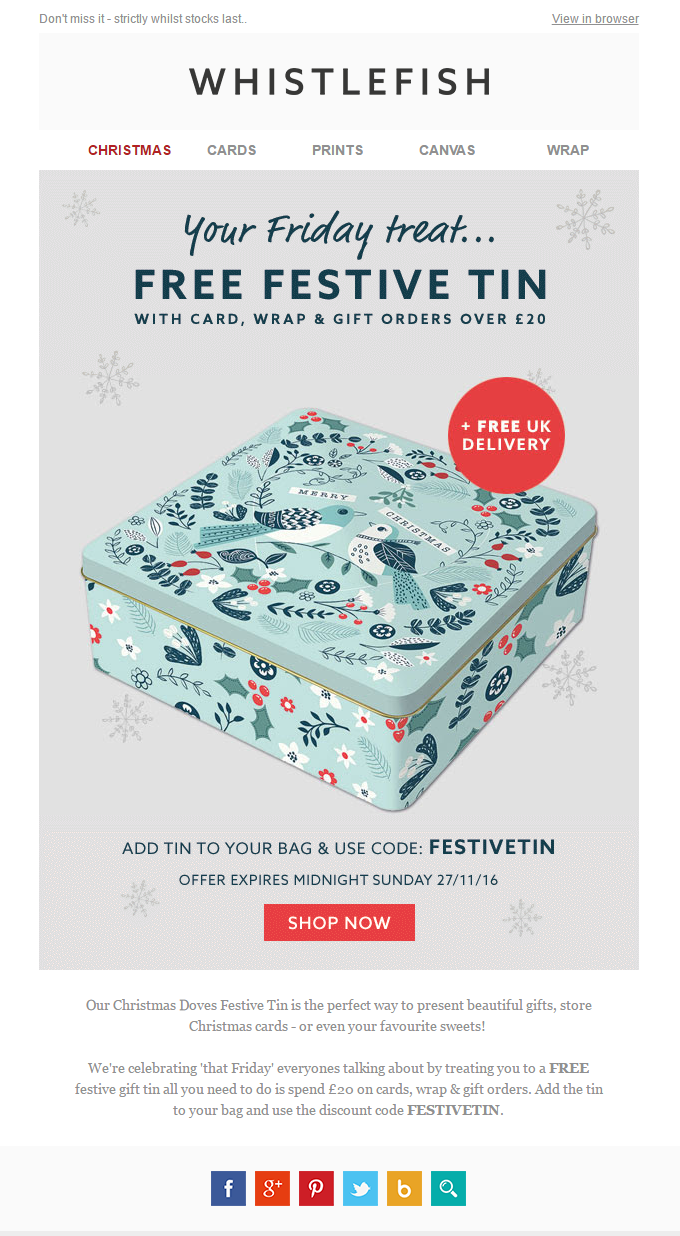
14. Content Compilation
This strategy can be especially effective for several reasons. On the one hand, you are adding value to your subscribers and reminding them that you have something good and useful to offer. On the other, it can help you recycle older content and bring you back to the forefront of your audience's mind.
Whether in the form of blog articles, videos, events related to your sector or your brand, tools or other useful resources, it is recommended that these compilation emails be focused to the specific audience segments created previously.
15. Recover Cold Leads
When working with email marketing, we often focus on those active subscribers ("hot leads") and forget about those who have a more distant behaviour ("cold leads").
In order to recover those "less active" subscribers, it is interesting to send a recovery campaign aimed exclusively at them.
To do this, segment the subscribers who have not opened your latest campaigns and have not made any purchases for a long time and send them a campaign to get their attention back. If you also accompany your campaigns with some kind of incentive (free downloadable, exclusive discount ...), you will have more chances of success.
Ryanair
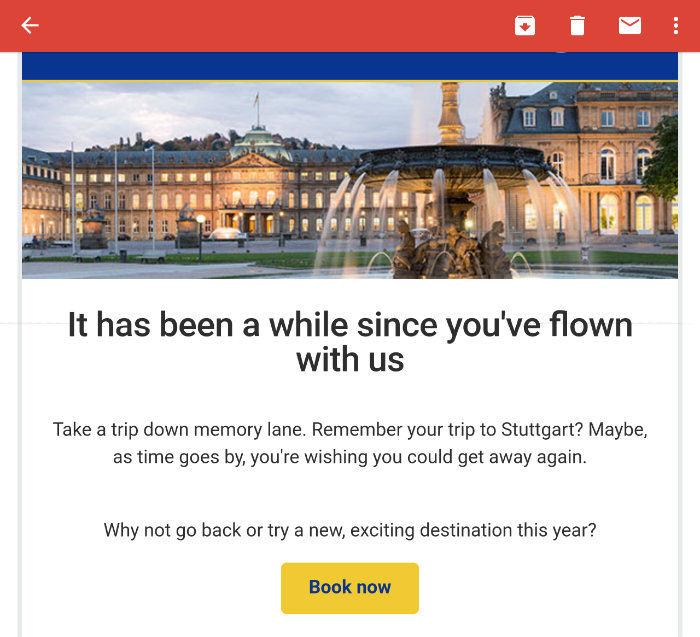
Conclusion
Don't underestimate the power of email marketing. Many bloggers and digital businesses see this channel as a very interesting way to increase and build loyalty and, in addition, to generate income.
You have a lot of great options besides the ones we just saw. The key is to know the audience you are addressing really well and generate good content for them.
Take your time to create a good hook capable of capturing subscribers, segment your list well based on the specific characteristics of these subscribers, prepare truly valuable content for your audience and plan the sending of email campaigns fully so you're not leaving anything to chance.
If you like this content you’re going to love everything else I do. I want to provide you with unbelievable value so you, too, can achieve all your business goals. Let me know what you think of this post and I'd be happy to help any of you guys who may be struggling with your own marketing strategies. Also check me out on Instagram, YouTube, and Facebook.
